Zoom
Trash

5E_Instructional_Model-Full_Report. The Five E's of Science Lyhyesti ja ytimekkäästi, mistä 5E eri vaiheissa on kyse! 5-E Model for Teaching Inquiry Science. The 5E Model by V ONeal. BSCS Katso videot kuinka 5e syntynyt ja kehittynyt! Tarvainen 5E mallista suomeksi ok esittely. Annikki Lappalaisen suomennos. The BSCS 5E Instructional Model - Creating Teachable Moments (PB356X): Rodger W. Bybee: 9781941316009: Amazon.com: Books. 5E malli ja 21st century skills. 5e_lesson_cycle. 5E laajennus 7E:ksi. The Learning Cycle in Elementary Science — Tundra: Life in the Polar Extremes.
Hands-on activity is important in science.
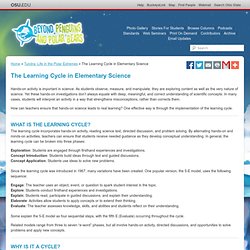
As students observe, measure, and manipulate, they are exploring content as well as the very nature of science. Yet these hands-on investigations don’t always equate with deep, meaningful, and correct understanding of scientific concepts. In many cases, students will interpret an activity in a way that strengthens misconceptions, rather than corrects them. How can teachers ensure that hands-on science leads to real learning? One effective way is through the implementation of the learning cycle. The learning cycle incorporates hands-on activity, reading science text, directed discussion, and problem solving. Exploration: Students are engaged through firsthand experiences and investigations.Concept Introduction: Students build ideas through text and guided discussions.Concept Application: Students use ideas to solve new problems.
Since the learning cycle was introduced in 1967, many variations have been created. 5E tutkimalla oppimisen suunnittelumalli luonnontiteiden opetukseen. Creating Teachable Moments with Rodger Bybee. Rodger Bybee esittely. Rodger W.
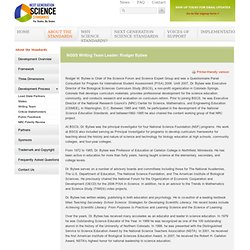
Bybee is Chair of the Science Forum and Science Expert Group and was a Questionnaire Panel Consultant for Program for International Student Assessment (PISA) 2006. Until 2007, Dr. Bybee was Executive Director of the Biological Sciences Curriculum Study (BSCS), a non-profit organization in Colorado Springs, Colorado that develops curriculum materials, provides professional development for the science education community, and conducts research and evaluation on curriculum reform. Prior to joining BSCS, he was Executive Director of the National Research Council’s (NRC) Center for Science, Mathematics, and Engineering Education (CSMEE), in Washington, D.C.
Between 1985 and 1995, he participated in the development of the National Science Education Standards, and between1992–1995 he also chaired the content working group of that NRC project. At BSCS, Dr. From 1972 to 1985, Dr. Dr. Dr. Over the years, Dr. Creating Teachable Moments with Rodger Bybee. 5E Lesson Planning. 5E report -What is Inquiry Sciecne (long version) 5E. The 5 E Learning Cycle Model. Priming the Pump: Peter Elbow's prompts to help students explore topics, objects, places, issues Questions to help a student write about someone s/he has studied or read about: · Describe _ as an ordinary person. · What was/is special or unique about _ ?
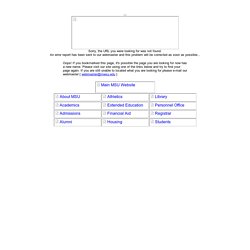
· Imagine _ were the opposite sex: describe the life s/he would have lived. · What if _ had lived in a different era, such as _ : describe the life s/he would have lived. · Make up or guess what might have been an important event in _'s childhood. · Create a soap opera plot with _ in it. · What does _ most need to cry about? · What should _ be most appreciated for?
5E tiivisti taulukkona (english) 5e Learning cycle. 1 Definition The 5e learning cycle is an instructional design model that defines a learning sequence based on the on the experiential learning philosophy of John Dewey and the experiential learning cycle proposed by David Kolb.
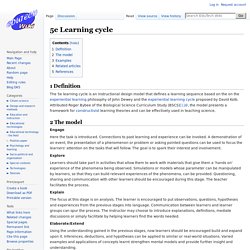
Attributed Roger Bybee of the Biological Science Curriculum Study (BSCS)[1], the model presents a framework for constructivist learning theories and can be effectively used in teaching science. 2 The model Engage. e5 presentation. 5 e lesson plan science examples - free ebook downloads.
Discovery Education SCIENCE and the 5E Model: Whitney Mihoulides #SSDOD2011. A DEN Account Manager for Discovery Education, Whitney Mihoulides focuses her presentation on digital media in the Science classroom.

Students are engaging with technology and digital media outside the classroom, so why not bring it inside the classroom. Digital media lets students see at the micro and sub-micro levels something you could not otherwise see. While digital media will not replace hands-on lab work, Discovery Science is designed to enhance your classroom inquiry. Today we are approaching the 5 E’s in a linear progression. Engagement is about getting students involved, generating interest. Depending on your platform, Science Elementary and Science Middle, your platform will look different, but each has the 5 Minute Preps. Exploration is an interactive introductory tool about a concept. The beauty of Discovery Science is that everything you need for robust lesson plans are embedded in the program. A very special thank you to Whitney for sharing a great Discovery resource. The learning cycle (huomaa ero 5E) The learning cycle is a model of instruction based on scientific inquiry.
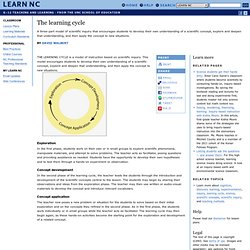
This model encourages students to develop their own understanding of a scientific concept, explore and deepen that understanding, and then apply the concept to new situations. Exploration In the first phase, students work on their own or in small groups to explore scientific phenomena, manipulate materials, and attempt to solve problems. The teacher acts as facilitator, posing questions and providing assistance as needed. Learning Cycle tuntisuunnitelmia ja LC kompakti esittely. The lesson plans on the AGPA website use the Learning Cycle as the instructional model for its lesson plans.
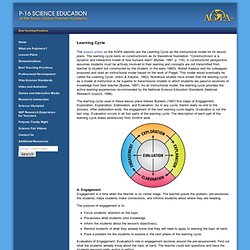
The learning cycle rests on constructivism as its theoretical foundation. "Constructivism is a dynamic and interactive model of how humans learn" (Bybee, 1997, p. 176). A constructivist perspective assumes students must be actively involved in their learning and concepts are not transmitted from teacher to student but constructed by the student. Learning Cycle. The lesson plans on the AGPA website use the Learning Cycle as the instructional model for its lesson plans.
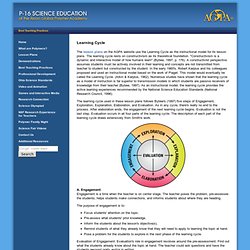
The learning cycle rests on constructivism as its theoretical foundation. "Constructivism is a dynamic and interactive model of how humans learn" (Bybee, 1997, p. 176). A constructivist perspective assumes students must be actively involved in their learning and concepts are not transmitted from teacher to student but constructed by the student. 5Es Overview: “The 5E instructional model”
5Es Overview: “The 5E instructional model” What is a 5E instructional model?
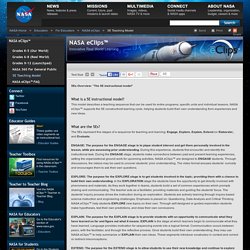
This model describes a teaching sequence that can be used for entire programs, specific units and individual lessons. NASA eClips™ supports the 5E constructivist learning cycle, helping students build their own understanding from experiences and new ideas. What are the 5Es? The 5Es represent five stages of a sequence for teaching and learning: Engage, Explore, Explain, Extend (or Elaborate), and Evaluate. Enhancing Education: The 5 E's. The 5 E's is an instructional model based on the constructivist approach to learning, which says that learners build or construct new ideas on top of their old ideas.

The 5 E's can be used with students of all ages, including adults. Each of the 5 E's describes a phase of learning, and each phase begins with the letter "E": Engage, Explore, Explain, Elaborate, and Evaluate. The 5 E's allows students and teachers to experience common activities, to use and build on prior knowledge and experience, to construct meaning, and to continually assess their understanding of a concept. Effect of the 5E Model on Prospective Teachers’ Conceptual Understanding of Diffusion and Osmosis: A Mixed Method Approach. 5 E instructional model. Designing a Lesson Using the 5E Model ~ Science ~ Instruction ~ School Improvement in Maryland. What scientific concept/principle should students learn from this lesson? Use indicators from the Science State Curriculum as a resource. Include indicators from both Skills and Processes (Standard 1) and Concepts (Standards 2-6). This is then developed into the culminating or the last in a series of logically connected activities.
It can be a problem students can solve or a decision students can make or a question students can answer. Biology ~ High School Assessments ~ Instruction ~ School Improvement in Maryland. 4_LAJPE_620_Ismet_Ergin_preprint_corr_f.